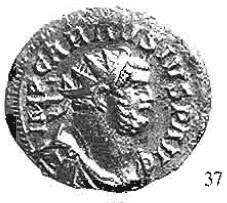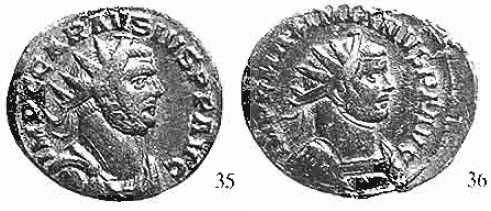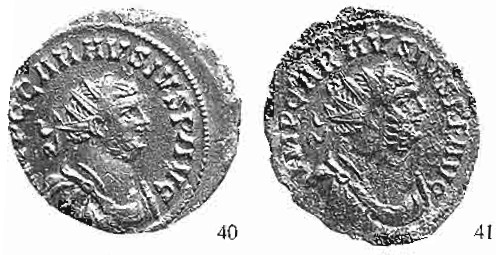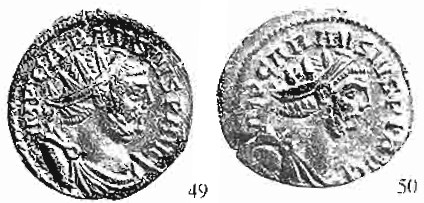Romano-British Empire, Carausius, Mid 286 - Mid 293 A.D.
Carausius| coins| for sale| in the Forum| Ancient| Coins| shop|
Marcus Aurelius Mausaeus Carausius was originally a fleet commander sent by the first Tetrarchs to rid the Northern seas of Saxon and Frankish pirates. He soon turned to piracy himself, before fleeing to Britain and declaring himself emperor. His natural cunning enabled him to resist all attempts to dislodge him. In 293 Constantius I captured his continental stronghold of Boulogne. Soon after Carausius was murdered by his chief minister Allectus.
Also see: ERIC - CARAUSIUS
References
Askew, G. The Coinage of Roman Britain. (London, 1980).
Beaujard, E.B. & H. Huvelin. "Le tresor de Rouen et l'occupation de la Gaule par Carausius" in Histoire et Numismatique en Haut-Normandie. (Caen, 1980).
Bland, R. "A Hoard of Carausius and Allectus from Burton Latimer" in BNJ 54 (1984), pp. 41 - 50. Available Online
Burnett, A. & J. Casey. A Carausian Hoard from Croydon, Surrey, and a Note on Carausius's Continental Possessions" in BNJ 54 (1984), pp. 10 - 20. Available Online
Calicó, X. The Roman Avrei, Vol. 2: From Didius Julianus to Constantius I, 193 AD - 335 AD. (Barcelona, 2003).
Carson, R.A.G. "The Sequence-marks on the Coinage of Carausius and Allectus" in Essays Baldwin (1971), pp. 57 - 65.
Casey, P.J. Carausius and Allectus: The British Usurpers. (New Haven, 1995).
Challis, C.E. & M.A.S. Blackburn. Studies in the Coinages of Carausius and Allectus. (London, 1985).
Cohen, H. Description historique des monnaies frappées sous l'Empire Romain, Vol. 7: Carausius to Constantine & Sons. (Paris, 1888).
Depeyrot, G. Les monnaies d'or de Dioclétien a Constantin I (284-337). (Wetteren, 1995).
Giard, J-B. "La monnaie de Carausius à Rouen: une remise en question" in RN 1995, Vol. 6, Issue 150, pp. 264 - 266. Available Online
King, C.E. "A Small Hoard of Carausius Found Near Bicester Oxfordshire" in BNJ 53, (1982), pp. 7 - 16. Available Online
King, C.E. "The Unmarked Coins of Carausius" in BNJ 54 (1984), pp. 1 - 9. Available Online
King, C.E. & D.R. Sear. Roman Silver Coins, Volume V, Carausius to Romulus Augustus. (London, 1987).
Mattingly, H., E.A. Sydenham & P. Webb. The Roman Imperial Coinage, Vol V, Part II, Probus to Amandus. (London, 1933).
Robinson, A. Roman Imperial Coins in the Hunter Coin Cabinet, University of Glasgow, Vol. IV. Valerian I to Allectus. (Oxford, 1978).
Schaaff, U. Münzen der römischen Kaiserzeit mit Schiffsdarstellungen im Römisch-Germanischen Zentralmuseum. (Munich, 2003).
Sear, D.R. Roman Coins and Their Values, Volume IV: The Tetrarchies and the Rise of the House of Constantine...Diocletian To Constantine I, AD 284 - 337. (London, 2011).
Shiel, N. The Episode of Carausius and Allectus. BAR 40. (Oxford, 1977).
Southerland, C.H.V. "'Carausius II', 'Censeris', and the Barbarous Fel. Temp. Reparatio Overstrikes" in NC 1945.
Vagi, D. Coinage and History of the Roman Empire. (Sidney, 1999).
Webb, P.H. The reign and coinage of Carausius. (London, 1908). Available Online
Webb, P.H. "The Linchmere Hoard" in NC 1925, pp. 173 - 235. Available Online
Mintmark sequences of the coinage of Carausius and Allectus
IMP CARAVSIVS P F AVG (286 - 291)
Londinium (London, England)
Unmarked, early reign moustache portrait, common (c. mid 286 - early/mid 287)
BRI, early reign moustache portrait, extremely rare (c. early/mid 287)
ML, mid-reign portrait (c. mid 287 - 288)
L-[ ] / ML, mid-reign portrait (c. 288 - 289)
F-O / ML, mid-reign portrait (c. 289 - 290)
B-E / MLXXI, B*-E / MLXXI, mid-reign portrait (c. 290 - 291)
Camulodunum (Colchester, England)
C, early reign moustache portrait/mid-reign portrait (c. mid 287 - 288)
MC, early reign moustache portrait, rare (c. 288 - 289)
SMC, early reign moustache portrait, rare (c. 288 - 289)
MSC, early reign moustache portrait, rare (c. 289 - 290)
CXXI, MCXXI, early reign moustache portrait (c. 290 - 291)
S-C / C, S-C / [ ], S-P / [ ], early reign moustache portrait/mid-reign portrait (c. 291)
Rotomagus (Rouen, France)
R, OPR, IOI, OPA (c. 287)
Uncertain (Probably London)
X, V, V*, L in field, early reign moustache portrait (c. mid 286 - mid 287)
XXI, XXX, early reign moustache portrait (c. mid 286 - mid 287)
RSR, early reign moustache portrait (c. mid 287)
IMP C CARAVSIVS P F AVG (291 - mid 293)
Londinium (London, England)
B-E / MLXXI, mid-reign portrait (c. 291)
S-P / MLXXI, mid-reign portrait/tetrarchic portrait (c. 292 - early 293)
S-P / ML, S-C / ML, tetrarchic portrait (c. early - mid 293)
Camulodunum (Colchester, England)
Unmarked, mid-reign portrait (c. 291 - 292)
S-P / [ ], S-C / [ ], mid-reign portrait/tetrarchic portrait (c. 291 - 292)
S-P / C, S-C / C, mid-reign portrait/tetrarchic portrait (c. 292 - early 293)
SPC, tetrarchic portrait, rare (c. 292 - mid 293)Webb Carausius
Webb, P.H. The reign and coinage of |Carausius. (London|, 1908). Available Online
1. Common obverse legends, referred to by numbers.
1. IMP CARAVSIVS AVG.
2. IMP CARAVSIVS P AV.
3. IMP CARAVSIVS P AVG.
4. IMP CARAVSIVS P F AV.
5. IMP CARAVSIVS P F AVG.
6. IMP C CARAVSIVS AVG.
7. IMP C CARAVSIVS IVG.
8. IMP C CARAVSIVS P AVG.
9. IMP C CARAVSIVS P F AVG.
2. Common types of bust, referred to by letters.
A. Radiate bust to right, draped.
B. Radiate bust to right, draped and cuirassed.
C. Radiate bust to right, cuirassed only.
D. Laureate bust to right, draped.
E. Laureate bust to right, draped and cuirassed.
R. Laureate bust to right, cuirassed only.
Contents
Londinium (London)....................92
Camulodunum (Colchester)....................120
Camulodunum (Colchester), S -, S - C, or S - P....................153
RSR....................164
Rotomagus (Rouen)....................178
UNCERTAIN
I. British Coins without Recorded Mint-Marks
Silver....................193
Bronze....................196
II Coins with Unattributed Mint-Marks
Silver....................238
Bronze....................240
Carausius, Diocletian and Maximian
Camulodunum (Colchester), Bronze....................242
Coins Issued by Carausius, Bearing Bust and Name of Diocletian
Londinium (London), Bronze....................243
Camulodunum (Colchester), Bronze....................245
Uncertain Mint, Bronze....................246
Coins Issued by Carausius, Bearing Bust and Name of Maximian
Londinium (London), Gold....................247
Camulodunum (Colchester), Bronze....................248
Uncertain Mint, Bronze....................248
Supplement....................250
Suggestion: Use this screen or copy and print this key to use the PDF faster and without having to scroll back.
Three Portrait Styles of Carausius
Source: King, C.E. "The Unmarked Coins of Carausius" in BNJ 54 (1984), pp. 1 - 9.There are three types of Carausius portraits: 1) an early-reign portrait with a full moustache, 2) a mid-reign portrait without a moustache or diminished moustache, and 3) a late-reign tetrarchic style portrait. For each of these three types there are two commons styles, most easily identified by the engraving of the mouth, one style has a straight mouth, the other style usually has a slight smile.
1) Early reign 'moustache' portrait. In the first type, Carausius is bearded and has a full moustache (e.g. Nos. 24-28 and 48-50). The 'moustache' portrait seems to occur mainly on C mint coins and unmarked pieces, and only very rarely on L mint pieces. At the C mint this portrait is restricted to the CXXI and MCXXI marks.


1) Straight mouth style portrait. In the first group it is engraved either as a straight line or a slightly diagonal one.
Portrait style 1 (the 'moustache' portrait): Nos. 24-28.







The obverses of Nos. 48-50 probably belong to this
group as well although the curve of the moustache obscures the line of
the mouth. They are quite different from the 'moustache' portrait of the
preceding group.
RIC V, Part 2, Carausius
|
Inscriptions referred to by number |
Busts referred to by letter |
DICTIONARY| OF ROMAN| COINS|
                | Please |help| us convert the |Dictionary of Roman Coins| from scans to text by typing the original text here. Please add updates or make corrections to the NumisWiki text version as appropriate. |
 | |
   | Please |help| us convert the |Dictionary of Roman Coins| from scans to text by typing the original text here. Please add updates or make corrections to the NumisWiki text version as appropriate. |
Romano-British Empire, Carausius, Mid 286 - Mid 293 A.D.
Carausius| coins| for sale| in the Forum| Ancient| Coins| shop|
Marcus Aurelius Mausaeus Carausius was originally a fleet commander sent by the first Tetrarchs to rid the Northern seas of Saxon and Frankish pirates. He soon turned to piracy himself, before fleeing to Britain and declaring himself emperor. His natural cunning enabled him to resist all attempts to dislodge him. In 293 Constantius I captured his continental stronghold of Boulogne. Soon after Carausius was murdered by his chief minister Allectus.
Also see: ERIC - CARAUSIUS
References
Askew, G. The Coinage of Roman Britain. (London, 1980).
Beaujard, E.B. & H. Huvelin. "Le tresor de Rouen et l'occupation de la Gaule par Carausius" in Histoire et Numismatique en Haut-Normandie. (Caen, 1980).
Bland, R. "A Hoard of Carausius and Allectus from Burton Latimer" in BNJ 54 (1984), pp. 41 - 50. Available Online
Burnett, A. & J. Casey. A Carausian Hoard from Croydon, Surrey, and a Note on Carausius's Continental Possessions" in BNJ 54 (1984), pp. 10 - 20. Available Online
Calicó, X. The Roman Avrei, Vol. 2: From Didius Julianus to Constantius I, 193 AD - 335 AD. (Barcelona, 2003).
Carson, R.A.G. "The Sequence-marks on the Coinage of Carausius and Allectus" in Essays Baldwin (1971), pp. 57 - 65.
Casey, P.J. Carausius and Allectus: The British Usurpers. (New Haven, 1995).
Challis, C.E. & M.A.S. Blackburn. Studies in the Coinages of Carausius and Allectus. (London, 1985).
Cohen, H. Description historique des monnaies frappées sous l'Empire Romain, Vol. 7: Carausius to Constantine & Sons. (Paris, 1888).
Depeyrot, G. Les monnaies d'or de Dioclétien a Constantin I (284-337). (Wetteren, 1995).
Giard, J-B. "La monnaie de Carausius à Rouen: une remise en question" in RN 1995, Vol. 6, Issue 150, pp. 264 - 266. Available Online
King, C.E. "A Small Hoard of Carausius Found Near Bicester Oxfordshire" in BNJ 53, (1982), pp. 7 - 16. Available Online
King, C.E. "The Unmarked Coins of Carausius" in BNJ 54 (1984), pp. 1 - 9. Available Online
King, C.E. & D.R. Sear. Roman Silver Coins, Volume V, Carausius to Romulus Augustus. (London, 1987).
Mattingly, H., E.A. Sydenham & P. Webb. The Roman Imperial Coinage, Vol V, Part II, Probus to Amandus. (London, 1933).
Robinson, A. Roman Imperial Coins in the Hunter Coin Cabinet, University of Glasgow, Vol. IV. Valerian I to Allectus. (Oxford, 1978).
Schaaff, U. Münzen der römischen Kaiserzeit mit Schiffsdarstellungen im Römisch-Germanischen Zentralmuseum. (Munich, 2003).
Sear, D.R. Roman Coins and Their Values, Volume IV: The Tetrarchies and the Rise of the House of Constantine...Diocletian To Constantine I, AD 284 - 337. (London, 2011).
Shiel, N. The Episode of Carausius and Allectus. BAR 40. (Oxford, 1977).
Southerland, C.H.V. "'Carausius II', 'Censeris', and the Barbarous Fel. Temp. Reparatio Overstrikes" in NC 1945.
Vagi, D. Coinage and History of the Roman Empire. (Sidney, 1999).
Webb, P.H. The reign and coinage of Carausius. (London, 1908). Available Online
Webb, P.H. "The Linchmere Hoard" in NC 1925, pp. 173 - 235. Available Online
Mintmark sequences of the coinage of Carausius and Allectus
IMP CARAVSIVS P F AVG (286 - 291)
Londinium (London, England)
Unmarked, early reign moustache portrait, common (c. mid 286 - early/mid 287)
BRI, early reign moustache portrait, extremely rare (c. early/mid 287)
ML, mid-reign portrait (c. mid 287 - 288)
L-[ ] / ML, mid-reign portrait (c. 288 - 289)
F-O / ML, mid-reign portrait (c. 289 - 290)
B-E / MLXXI, B*-E / MLXXI, mid-reign portrait (c. 290 - 291)
Camulodunum (Colchester, England)
C, early reign moustache portrait/mid-reign portrait (c. mid 287 - 288)
MC, early reign moustache portrait, rare (c. 288 - 289)
SMC, early reign moustache portrait, rare (c. 288 - 289)
MSC, early reign moustache portrait, rare (c. 289 - 290)
CXXI, MCXXI, early reign moustache portrait (c. 290 - 291)
S-C / C, S-C / [ ], S-P / [ ], early reign moustache portrait/mid-reign portrait (c. 291)
Rotomagus (Rouen, France)
R, OPR, IOI, OPA (c. 287)
Uncertain (Probably London)
X, V, V*, L in field, early reign moustache portrait (c. mid 286 - mid 287)
XXI, XXX, early reign moustache portrait (c. mid 286 - mid 287)
RSR, early reign moustache portrait (c. mid 287)
IMP C CARAVSIVS P F AVG (291 - mid 293)
Londinium (London, England)
B-E / MLXXI, mid-reign portrait (c. 291)
S-P / MLXXI, tetrarchic portrait (c. 292 - early 293)
S-P / ML, S-C / ML, tetrarchic portrait (c. early - mid 293)
Camulodunum (Colchester, England)
Unmarked, mid-reign portrait (c. 291 - 292)
S-P / [ ], S-C / [ ], mid-reign portrait/tetrarchic portrait (c. 291 - 292)
S-P / C, S-C / C, mid-reign portrait/tetrarchic portrait (c. 292 - early 293)
SPC, tetrarchic portrait, rare (c. 292 - mid 293)Webb Carausius
Webb, P.H. The reign and coinage of |Carausius. (London|, 1908). Available Online
1. Common obverse legends, referred to by numbers.
1. IMP CARAVSIVS AVG.
2. IMP CARAVSIVS P AV.
3. IMP CARAVSIVS P AVG.
4. IMP CARAVSIVS P F AV.
5. IMP CARAVSIVS P F AVG.
6. IMP C CARAVSIVS AVG.
7. IMP C CARAVSIVS IVG.
8. IMP C CARAVSIVS P AVG.
9. IMP C CARAVSIVS P F AVG.
2. Common types of bust, referred to by letters.
A. Radiate bust to right, draped.
B. Radiate bust to right, draped and cuirassed.
C. Radiate bust to right, cuirassed only.
D. Laureate bust to right, draped.
E. Laureate bust to right, draped and cuirassed.
R. Laureate bust to right, cuirassed only.
Contents
Londinium (London)....................92
Camulodunum (Colchester)....................120
Camulodunum (Colchester), S -, S - C, or S - P....................153
RSR....................164
Rotomagus (Rouen)....................178
UNCERTAIN
I. British Coins without Recorded Mint-Marks
Silver....................193
Bronze....................196
II Coins with Unattributed Mint-Marks
Silver....................238
Bronze....................240
Carausius, Diocletian and Maximian
Camulodunum (Colchester), Bronze....................242
Coins Issued by Carausius, Bearing Bust and Name of Diocletian
Londinium (London), Bronze....................243
Camulodunum (Colchester), Bronze....................245
Uncertain Mint, Bronze....................246
Coins Issued by Carausius, Bearing Bust and Name of Maximian
Londinium (London), Gold....................247
Camulodunum (Colchester), Bronze....................248
Uncertain Mint, Bronze....................248
Supplement....................250
Suggestion: Use this screen or copy and print this key to use the PDF faster and without having to scroll back.
Three Portrait Styles of Carausius
Source: King, C.E. "The Unmarked Coins of Carausius" in BNJ 54 (1984), pp. 1 - 9.There are three types of Carausius portraits: 1) an early-reign portrait with a full moustache, 2) a mid-reign portrait without a moustache or diminished moustache, and 3) a late-reign tetrarchic style portrait. For each of these three types there are two commons styles, most easily identified by the engraving of the mouth, one style has a straight mouth, the other style usually has a slight smile.
1) Early reign 'moustache' portrait. In the first type, Carausius is bearded and has a full moustache (e.g. Nos. 24-28 and 48-50). The 'moustache' portrait seems to occur mainly on C mint coins and unmarked pieces, and only very rarely on L mint pieces. At the C mint this portrait is restricted to the CXXI and MCXXI marks.


1) Straight mouth style portrait. In the first group it is engraved either as a straight line or a slightly diagonal one.
Portrait style 1 (the 'moustache' portrait): Nos. 24-28.







The obverses of Nos. 48-50 probably belong to this
group as well although the curve of the moustache obscures the line of
the mouth. They are quite different from the 'moustache' portrait of the
preceding group.
RIC V, Part 2, Carausius
|
Inscriptions referred to by number |
Busts referred to by letter |
DICTIONARY| OF ROMAN| COINS|
                | Please |help| us convert the |Dictionary of Roman Coins| from scans to text by typing the original text here. Please add updates or make corrections to the NumisWiki text version as appropriate. |
 | |
   | Please |help| us convert the |Dictionary of Roman Coins| from scans to text by typing the original text here. Please add updates or make corrections to the NumisWiki text version as appropriate. |


